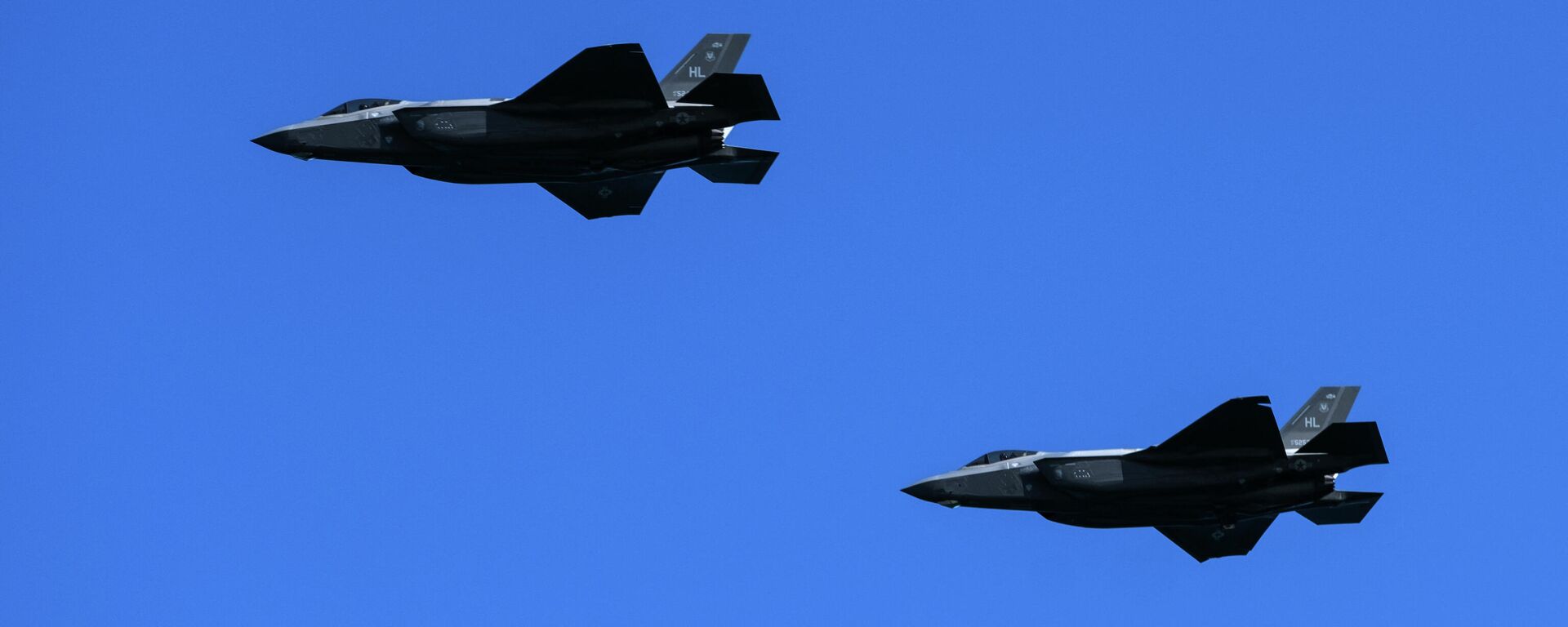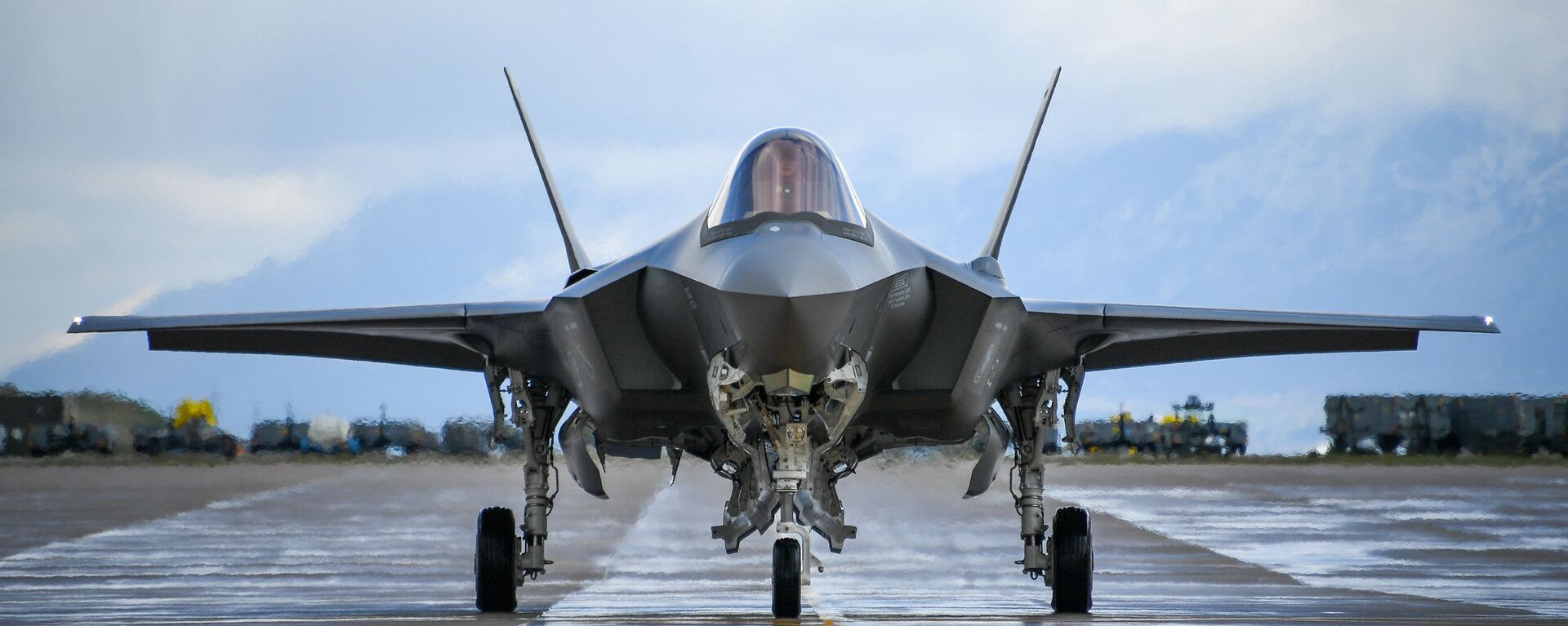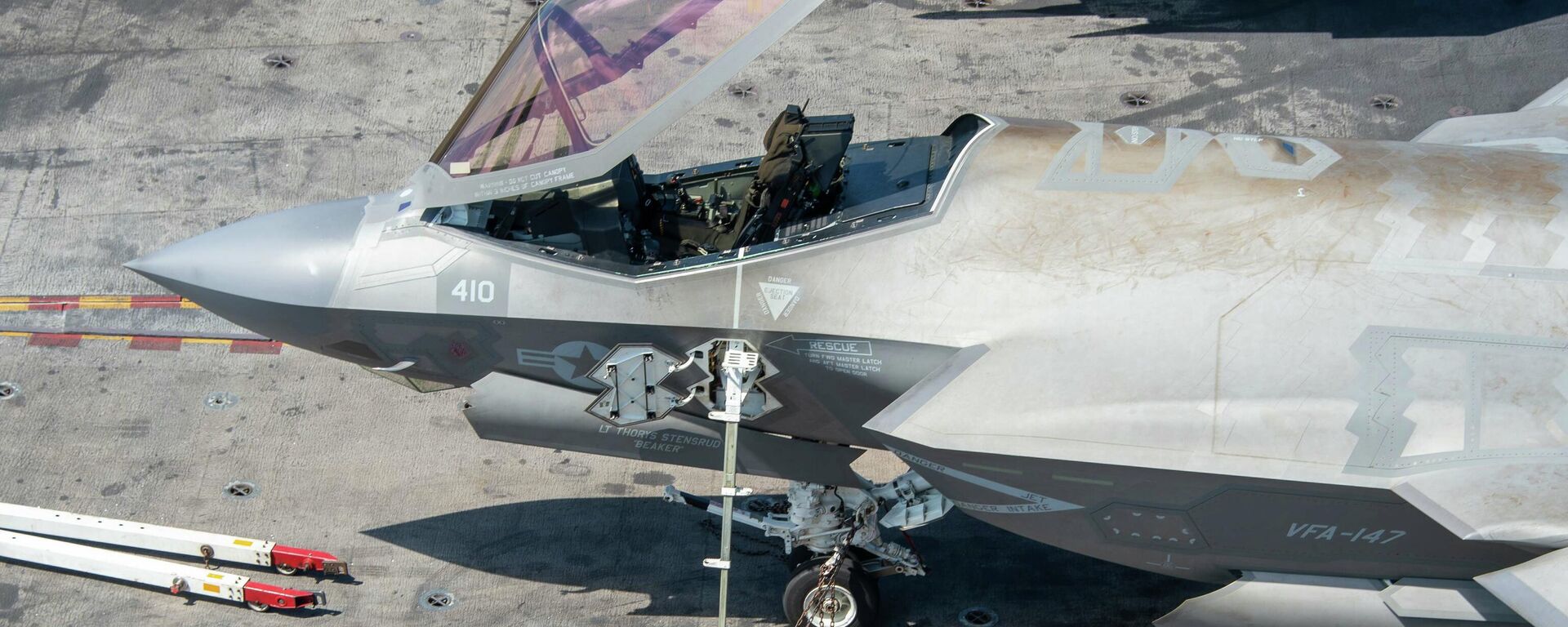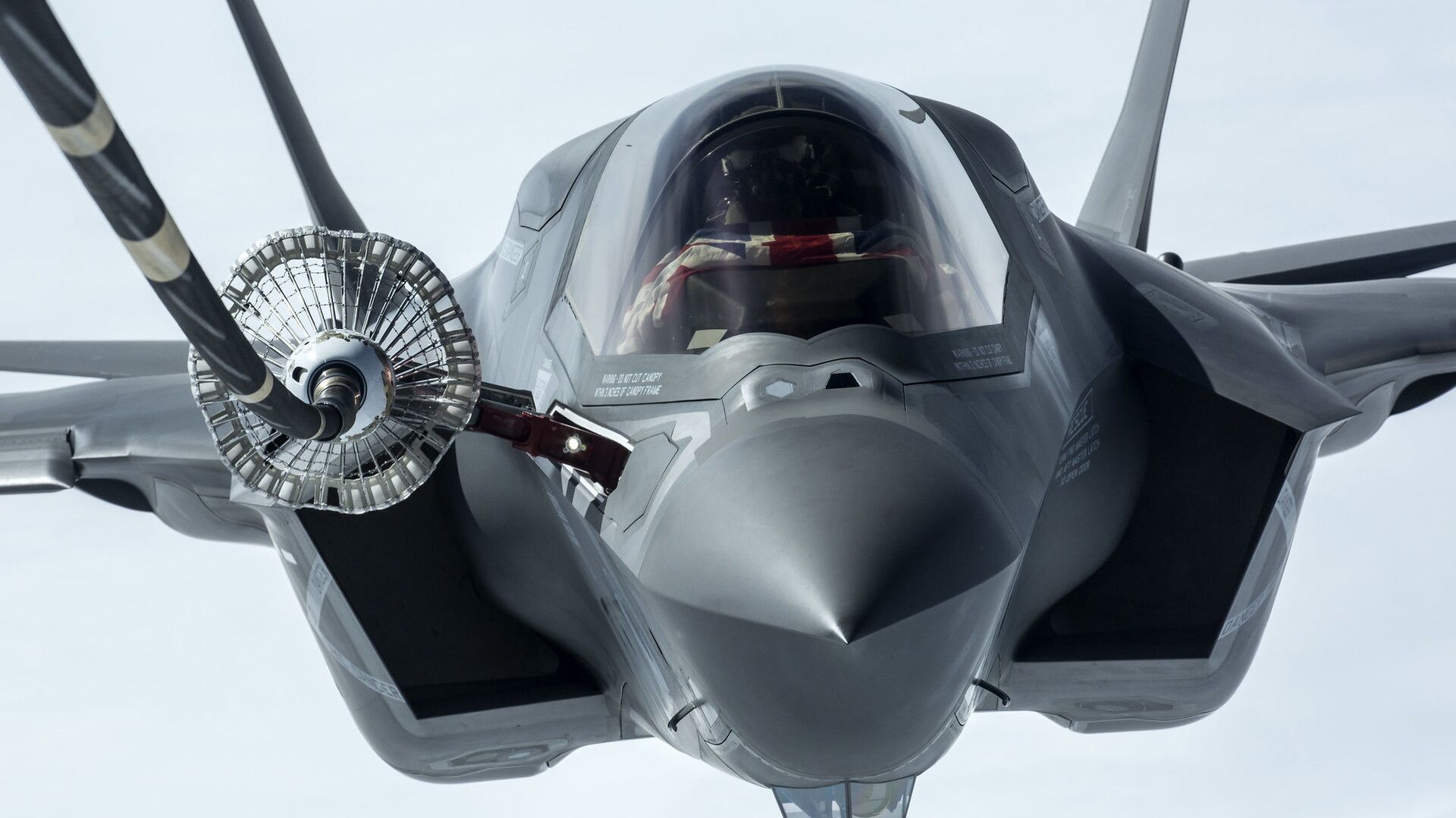https://sputnikglobe.com/20221213/from-neck-breaking-ejection-seats-to-frightening-lightning-f-35s-top-ten-problems-1105426616.html
From Neck-Breaking Ejection Seats to Frightening Lightning: F-35’s Top Ten Problems
From Neck-Breaking Ejection Seats to Frightening Lightning: F-35’s Top Ten Problems
Sputnik International
The Lockheed Martin F-35 Lightning II is the most expensive weapon in history, with a per unit price between $78 and $95 million, and a lifetime operations and... 13.12.2022, Sputnik International
2022-12-13T17:38+0000
2022-12-13T17:38+0000
2023-04-13T12:44+0000
military
f-35
lockheed martin f-35c joint strike fighter
lockheed martin
jet
fighter jet
problems
issues
glitch
hardware
https://cdn1.img.sputnikglobe.com/img/107604/46/1076044610_0:103:2047:1254_1920x0_80_0_0_fa5ed5c4a845a94b2316fb9ddf7cbfac.jpg
With its overall $1.7 trillion price tag roughly equivalent to the annual GDP of Australia, or more than twenty times Russia’s annual defense budget, one might expect US weapons giant Lockheed Martin to show a little humility when it comes to requesting more cash to fix issues affecting the F-35.But it seems that’s too much to ask. Last week, US media reported that cost overruns for upgrades to the jet’s sophisticated cockpit computers had reached $680 million, nearly matching the $712 million the Pentagon originally planned to spend on upgrading them (for a total cost of $1.3 billion). Adding insult to injury, the F-35 Joint Program Office announced that the upgrades wouldn’t be completed by the agreed-upon completion deadline of July 2023, with the timeframe pushed back to the end of 2023.Separately this month, the US Congressional Research Service revealed that the Pentagon wants an unspecified amount of cash for upgrades to the plane’s engines, promising that the new ones will reduce annual sustainment costs, which jumped from $79 million in 2016 to $315 million in 2020, and are projected to reach over $1 billion by 2028.Fortunately for Lockheed, cost overruns aren’t a problem. Actually, they’re baked into the agreements on the planes’ acquisition signed by the United States and its allies, with the company enjoying “cost-plus,” “undefinitized” contracts which make any unexpected costs the buyer’s problem (i.e. governments and their taxpayers). Some of Washington’s allies have caught on to the scheme. Last week, one angry Australian defense expert demanded that Canberra get a refund for its existing F-35s and stop buying new ones after calculating that the plane’s “killer” price tag, range limitations, and reliance on a hackable data communications link based thousands of kilometers away in the US makes it a bad buy for the Land Down Under.The US Government Accountability Office (GAO) issues yearly updates on the F-35’s projected costs, as well as outstanding problems associated with the plane. In its 2022 report, the GAO calculated that seven years after its introduction, the plane still has four major “Category 1” deficiencies, and 822 lesser “Category 2” problems.Here are some of the issues the jet has faced over the years:10. Cabin OverpressurizationThe 2022 GAO report outlined “cabin overpressurization” as one of these outstanding Category 1 deficiencies. The watchdog did not elaborate on the scale, nature and causes of the problem. However, an overpressurized cabin can be a big deal, causing ear popping, temporary hearing loss, headaches, sinus pain, and, if it’s severe enough, ruptured eardrums, permanent hearing loss, and loss of consciousness. It goes without saying that for the pilot of an $80 million aircraft flying through the skies at speeds up to 2,000 km an hour, an overpressurized cabin can problematic.9. Night Vision Problems“Issues” with the F-35’s night vision camera are another “critical deficiency” highlighted in the GAO’s 2022 report. The document did not offer details, but earlier reports on the matter pointed to a range of potential problems – from failing to operate when there is no Moon, to annoying horizontal lines, or striations, in the night vision display. Other issues, including a disorienting “green glow,” have also been reported, with the latter feeding video from a built-in camera onto the headgear display, obscuring the pilot’s vision during night flight. Last year, the Pentagon announced that fixes to these issues would involve upgrading the planes’ $400,000-a-piece integrated night vision helmets. However, not all branches of the US military have approved the acquisition of the new equipment.8. Lightning StrikesGiven its name, the F-35 Lightning II has an ironic propensity to suffer from problems related to stormy weather, with the Marine Corps expressing concerns as far back as 2018 that “as a composite type aircraft,” the plane “does not provide inherent passive lightning protection.” A 2012 Pentagon report concluded that the planes’ operation is unsafe within 40 km of a thunderstorm amid fears that lightning could damage or destroy aircraft if it struck their fuel tank inerting system. The Air Force announced earlier this year that it will fix lightning danger-related issues by 2025.7. Software BugsSoftware bugs with the aircraft’s onboard computer and its 8 million+ lines of code are a persistently-reported problem for the F-35, with the issue apparently getting so bad that the Pentagon called in software experts from top American universities last year for advice on how to resolve the persisting issues. A $14 billion software upgrade promises to fix a range of issues, from weapons functionality and communications to navigation, cybersecurity and targeting, but the Pentagon has already called the patch “immature, deficient and insufficiently tested.”6. Radar HeadachesIn 2016, the Pentagon confirmed that the F-35 had a problem involving the shutdown of its radar system once every four hours. After shutdown, it would reportedly take “a few minutes” for the radar to “regain picture” – a not-insignificant issue for a warplane, where “a few minutes” can be the difference between flying over your target or finding yourself a hundred or more kilometers away.5. CorrosionF-35 jets feature an advanced radar-absorbent skin, designed to improve stealth capabilities against cutting-edge enemy radar. However, photos of Navy F-35s published earlier this year showed that the planes’ skin appears to be suffering from severe corrosion thanks to its use of an iron ball paint designed to scramble radio waves. It’s not clear if and how Lockheed plans to address the problem, but as with almost every other problem involving the aircraft, a fix probably won’t be easy, or cheap.4. Breakneck ActionOne of the most serious problems with the F-35 has been its faulty ejection seats. In 2015, low-speed ejection tests revealed that the aircraft’s ejection seat systems were snapping crash test dummies’ necks. In 2016, the Pentagon responded by beginning testing of a reinforced helmet designed to keep pilots’ precious necks safe. A year later, the Air Force reported that tinkering with the planes’ ejection seat systems had alleviated the danger, allowing the military to lift pilot weight requirements.3. TrackabilityOne of the F-35’s biggest selling points is its stealthiness – the ability to fly into and out of enemy territory undetected, fire its munitions, and leave before ever being engaged by enemy missiles. However, even before substantial quantities of the aircraft were built, a flurry of reports indicated that Russian, Chinese, and Iranian designers had developed radars capable of detecting the jets at long ranges. Of course, only time, and radar and air defenses' interactions with F-35 in real-life environments, will determine the true significance of the aircraft's trackability.2. Lockheed’s Nary a Care CultureOver seven years after its introduction, the F-35 has not yet received approval from the Pentagon for full-rate production. That’s because the US military has not completed the jet’s certification. To date, Lockheed has yet to make good on its requirement to provide the Pentagon with detailed data for the Joint Simulation Environment – a virtual training domain designed to test the F-35’s hypothetical performance against top Chinese and Russian aircraft. The company promises to provide the military with data from 64 JSE tests by the summer of 2023.Despite the lack of certification, the Pentagon has already taken delivery of hundreds of F-35s, and expects to receive about one-third of its 2,470-plane F-35 fleet before full-rate production is granted, with all the problems that come with it –including issues upgrading and fixing problems with jets already built and bought.1. Single-Engine DesignArguably the F-35’s biggest problem, and a flaw that no amount of tinkering will be able to fix, is its single-engine, ‘one size fits all’ design. Lockheed’s decision to use a single, Pratt & Whitney F135 afterburning turbofan means that, if the plane suffers a major malfunction at sea, or damage to its engine while engaged in combat against an enemy plane or ground-based air defenses, it would become nearly impossible for it to limp safely back to base. Japan’s Air Force had cause to ponder this issue in 2019, when one of its F-35A jets was lost at sea after its pilot suffered spacial disorientation.
https://sputnikglobe.com/20221209/new-f-35-cockpit-computer-costs-reportedly-soar-by-680mln-through-expenses-delays-1105280666.html
https://sputnikglobe.com/20220203/us-air-force-says-will-finally-fix-lightning-strike-problem-that-grounded-f-35s-during-storms-1092732808.html
https://sputnikglobe.com/20220201/photos-us-navys-f-35-stealth-fighters-seem-to-be-rusting-on-south-china-sea-voyage-1092648254.html
https://sputnikglobe.com/20191007/india-to-upgrade-its-sukhoi-with-radar-capable-of-detecting-f-35-chinese-j-20---analyst-1076979232.html
Sputnik International
feedback@sputniknews.com
+74956456601
MIA „Rossiya Segodnya“
2022
News
en_EN
Sputnik International
feedback@sputniknews.com
+74956456601
MIA „Rossiya Segodnya“
Sputnik International
feedback@sputniknews.com
+74956456601
MIA „Rossiya Segodnya“
f-35, f-35 lightning ii, lockheed martin, cost overrun, expense, price, cabin pressure, night vision, lightning, software bugs, radar, corrosion, ejection seats, single-engine
f-35, f-35 lightning ii, lockheed martin, cost overrun, expense, price, cabin pressure, night vision, lightning, software bugs, radar, corrosion, ejection seats, single-engine
From Neck-Breaking Ejection Seats to Frightening Lightning: F-35’s Top Ten Problems
17:38 GMT 13.12.2022 (Updated: 12:44 GMT 13.04.2023) The Lockheed Martin F-35 Lightning II is the most expensive weapon in history, with a per unit price between $78 and $95 million, and a lifetime operations and sustainment cost of a whopping $1.3 trillion. Yet years after its introduction, the plane has continued to plague operators with a host of problems.
With its overall $1.7 trillion price tag roughly equivalent to the annual GDP of Australia, or more than twenty times Russia’s annual defense budget, one might expect US weapons giant Lockheed Martin to show a little humility when it comes to requesting more cash to fix issues affecting the F-35.
But it seems that’s too much to ask. Last week, US media reported that cost overruns for upgrades to the jet’s sophisticated cockpit computers had reached $680 million, nearly matching the $712 million the Pentagon originally planned to spend on upgrading them (for a total cost of $1.3 billion). Adding insult to injury, the F-35 Joint Program Office announced that the upgrades wouldn’t be completed by the agreed-upon completion deadline of July 2023, with the timeframe pushed back to the end of 2023. Separately this month, the US Congressional Research Service
revealed that the Pentagon wants an unspecified amount of cash for upgrades to the plane’s engines, promising that the new ones will reduce annual sustainment costs, which jumped from $79 million in 2016 to $315 million in 2020, and are projected to reach over $1 billion by 2028.

9 December 2022, 16:22 GMT
Fortunately for Lockheed, cost overruns aren’t a problem. Actually, they’re baked into the agreements on the planes’ acquisition signed by the United States and its allies, with the company enjoying “cost-plus,” “undefinitized” contracts which make any unexpected costs the buyer’s problem (i.e. governments and their taxpayers). Some of Washington’s allies have caught on to the scheme. Last week, one angry Australian defense expert
demanded that Canberra get a refund for its existing F-35s and stop buying new ones after calculating that the plane’s “killer” price tag, range limitations, and reliance on a hackable data communications link based thousands of kilometers away in the US makes it a bad buy for the Land Down Under.
The US Government Accountability Office (GAO) issues yearly updates on the F-35’s projected costs, as well as outstanding problems associated with the plane. In its 2022
report, the GAO calculated that seven years after its introduction, the plane still has four major “Category 1” deficiencies, and 822 lesser “Category 2” problems.
Here are some of the issues the jet has faced over the years:
10. Cabin Overpressurization
The 2022 GAO report
outlined “cabin overpressurization” as one of these outstanding Category 1 deficiencies. The watchdog did not elaborate on the scale, nature and causes of the problem. However, an overpressurized cabin can be a big deal, causing ear popping, temporary hearing loss, headaches, sinus pain, and, if it’s severe enough, ruptured eardrums, permanent hearing loss, and loss of consciousness. It goes without saying that for the pilot of an $80 million aircraft flying through the skies at speeds up to 2,000 km an hour, an overpressurized cabin can problematic.
“Issues” with the F-35’s night vision camera are another “critical deficiency” highlighted in the GAO’s 2022 report. The document did not offer details, but earlier
reports on the matter pointed to a range of potential problems – from failing to operate when there is no Moon, to annoying horizontal lines, or striations, in the night vision display. Other issues, including a disorienting
“green glow,” have also been reported, with the latter feeding video from a built-in camera onto the headgear display, obscuring the pilot’s vision during night flight. Last year, the Pentagon
announced that fixes to these issues would involve upgrading the planes’ $400,000-a-piece integrated night vision helmets. However, not all branches of the US military have approved the acquisition of the new equipment.
Given its name, the F-35 Lightning II has an ironic propensity to suffer from
problems related to stormy weather, with the Marine Corps expressing concerns as far back as 2018 that “as a composite type aircraft,” the plane “does not provide inherent passive lightning protection.” A 2012 Pentagon report concluded that the planes’ operation is
unsafe within 40 km of a thunderstorm amid fears that lightning could damage or destroy aircraft if it struck their fuel tank inerting system. The Air Force announced earlier this year that it will fix lightning danger-related issues
by 2025.

3 February 2022, 23:25 GMT
Software bugs with the aircraft’s onboard computer and its 8 million+ lines of code are a persistently-reported problem for the F-35, with the issue apparently getting so bad that the Pentagon called in software experts from top American universities last year
for advice on how to resolve the persisting issues. A $14 billion software upgrade promises to fix a range of issues, from weapons functionality and communications to navigation, cybersecurity and targeting, but the Pentagon has already called the patch
“immature, deficient and insufficiently tested.”In 2016, the Pentagon confirmed that the F-35 had a problem involving the shutdown of its radar system once every four hours. After shutdown, it would reportedly take
“a few minutes” for the radar to “regain picture” – a not-insignificant issue for a warplane, where “a few minutes” can be the difference between flying over your target or finding yourself a hundred or more kilometers away.
F-35 jets feature an advanced radar-absorbent skin, designed to improve stealth capabilities against cutting-edge enemy radar. However, photos of Navy F-35s published earlier this year showed that the planes’ skin appears to be suffering from severe corrosion thanks to its use of an iron ball paint designed to scramble radio waves. It’s not clear if and how Lockheed plans to address the problem, but as with almost every other problem involving the aircraft, a fix probably won’t be easy, or cheap.

1 February 2022, 00:26 GMT
One of the most serious problems with the F-35 has been its faulty ejection seats. In 2015, low-speed ejection tests
revealed that the aircraft’s ejection seat systems were snapping crash test dummies’ necks. In 2016, the Pentagon responded by
beginning testing of a reinforced helmet designed to keep pilots’ precious necks safe. A year later, the Air Force reported that tinkering with the planes’ ejection seat systems had alleviated the danger,
allowing the military to lift pilot weight requirements.
One of the F-35’s biggest selling points is its stealthiness – the ability to fly into and out of enemy territory undetected, fire its munitions, and leave before ever being engaged by enemy missiles. However, even before substantial quantities of the aircraft were built, a flurry of reports indicated that
Russian,
Chinese, and
Iranian designers had developed radars capable of detecting the jets at long ranges. Of course, only time, and radar and air defenses' interactions with F-35 in real-life environments, will determine the true significance of the aircraft's trackability.

7 October 2019, 13:28 GMT
2. Lockheed’s Nary a Care Culture
Over seven years after its introduction, the F-35 has not yet received approval from the Pentagon for full-rate production. That’s because the US military
has not completed the jet’s certification. To date, Lockheed has yet to make good on its requirement to provide the Pentagon with detailed data for the Joint Simulation Environment – a virtual training domain designed to test the F-35’s hypothetical performance against top Chinese and Russian aircraft. The company promises to provide the military with data from 64 JSE tests
by the summer of 2023.
Despite the lack of certification, the Pentagon has already taken delivery of hundreds of F-35s, and expects to receive about
one-third of its 2,470-plane F-35 fleet before full-rate production is granted, with all the problems that come with it –including issues upgrading and fixing problems with jets already built and bought.
Arguably the F-35’s biggest problem, and a flaw that no amount of tinkering will be able to fix, is its single-engine, ‘one size fits all’ design. Lockheed’s decision to use a single, Pratt & Whitney F135 afterburning turbofan
means that, if the plane suffers a major malfunction at sea, or damage to its engine while engaged in combat against an enemy plane or ground-based air defenses, it would become nearly impossible for it to limp safely back to base. Japan’s Air Force had cause to ponder this issue in 2019, when one of its F-35A jets was
lost at sea after its pilot suffered spacial disorientation.






